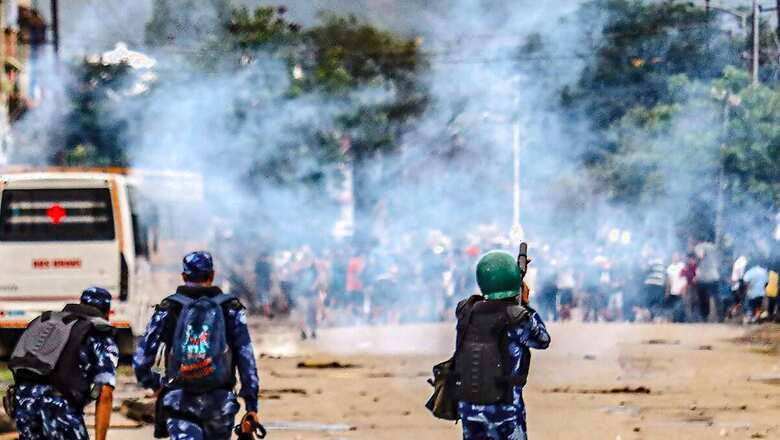
views
Myanmar, like Mexico, has become a formidable production centre for narcotics. Today, Myanmar is the largest producer of methamphetamine in the world. It is also a global centre for the production of crystal methamphetamine and, with a production capacity of 1,080 tonnes of illicit opium, ranks number one among opium-producing countries. The winding 1,643 km Indo-Myanmar border is a hotbed of drug trafficking activity. Manipur and Mizoram serve as major transit hubs for drug trafficking from Myanmar. Manipur Police seized $127 million worth of drugs between July 2022 and July 2023.
It was against this backdrop that the 7th Myanmar-India Bilateral Meeting on Drug Control took place in January 2024. The 7th DG-level virtual talks on Drug Control Cooperation between CCDAC (Central Committee on Drug Abuse Control) and NCB (Narcotics Control Bureau), India, were organised in Nay Pyi Taw, with the attendance of Police Brig-Gen Win Naing, Joint Secretary of the Central Committee on Drug Abuse Control and Commander of the Drug Enforcement Division.
The majority of synthetic drug and opium production in Myanmar is concentrated in the Shan state’s ‘special regions,’ controlled by various rebel groups like the United Wa State Army and the National Democratic Alliance Army. This area is in close proximity to China and Southeast Asian drug and precursor markets. In 2023, a UNODC report noted that the illicit manufacture of drugs in Shan state is increasingly expanding to neighbouring countries. As a result, on February 8, 2024, the Government of India decided to scrap the Free Movement Regime (FMR) along the 1,643 km Indo-Myanmar border to ensure internal security and maintain the demographic structure of India’s Northeastern states.
The Myanmar border will become the third frontier that India fences, following the borders with Pakistan and Bangladesh. A patrol track along the border will also be paved. A 10-km stretch of the border in Moreh, in ethnic violence-hit Manipur, has already been fenced. Two pilot projects for fencing through a hybrid surveillance system are under execution in Arunachal Pradesh and Manipur. Fencing works covering around 20 km in Manipur have also been approved. Predictably, many tribal groups in Manipur, especially the Kuki-Chin, are resisting the fencing.
The Kuki-Chin have close ties with the Bangladesh-based Al-Qaeda terror group, and both are targeting the Meitei tribe, which is predominantly Hindu. This is a dangerous communal twist that is being exploited by the Bangladesh-based radical group Jamaatul Ansar Fil Hindal Shariyaq, or Jamaatul Ansar, which has developed close ties with the Kuki-Chin National Front (KNF). Both Jamaat and KNF are conducting arms training camps in the Chittagong Hill Tracts. Drug money from Myanmar for weapons, coupled with a radical agenda and training from Al-Qaeda, has led to a significant arms accumulation among the Kukis. According to the Manipur Police, the Kukis are in possession of high-flying drones, missile systems, projectiles, AK-47s, INSAS rifles, and carbines. An estimated 6,000 arms are in their custody, raising concerns that a full-fledged escalation of tensions could grip the entire Northeast.
On April 29, 2024, the Assam Rifles recovered weapons from the Mon district of Nagaland, which is very close to Myanmar. These weapons included mortars, satellite phones, pistols, tubes, and other war-like stores. The use of drones and missiles clearly suggests that war-like stores are available to Kuki Zo militants, and uninterrupted supplies are coming from the Myanmar border. These groups have likely received weapons training from the Kuki-Chin in Myanmar. Furthermore, firing these missiles requires specialised training to assess trajectory and calculate wind speed.
The availability of easy drug money, the flow of weapons from Myanmar, and the involvement of insurgent groups from Bangladesh create a deadly cocktail that highlights the ongoing plight of the Meitei community in the region. Around 13,000 Meiteis have been forced to flee their homes in search of safety. The urgency of the situation compelled 1,600 households (comprising 13,000 individuals, including elders, women, and children) to abandon their homes during the evening hours, often in the dark of night. Their lives were at stake, leaving them with no choice but to flee. The creation of a buffer zone overnight prevents these Meitei families from returning to their homes. The aftermath of destruction is evident, with houses reduced to gravel and rubble. All Meitei homes were bulldozed and flattened using detonators.
In the current ongoing conflict between the Kukis and the Meiteis, another player lurks in the background: the Arakan Rohingya Salvation Army (ARSA). ARSA has been identified as a terrorist group by the governments of Myanmar, Bangladesh, China, and India. However, ARSA portrays itself as an ethnic armed group (EAG) with a legitimate claim to represent the Muslim Rohingya community. The Rohingya inhabit the Rakhine state area, which borders Bangladesh.
ARSA engaged in military operations in 2016 and 2017, prompting the country’s military, known as the Tatmadaw, to conduct responses that resulted in large-scale forced deportations of Rohingya to Bangladesh. ARSA’s leader is Ataullah Abu Ammar Jununi, commonly known as Ata Ullah, who is understood to be a Pakistan-born Rohingya and has lived much of his life in Saudi Arabia. Little is known about ARSA’s early funders, but the International Crisis Group believes that financing comes from a committee of supporters in Mecca and Medina, although their identities remain unclear.
ARSA’s presence in the Rohingya refugee camps in Bangladesh facilitates easier access for transnational jihadi groups and ARSA’s leadership and members to connect with each other. Further complicating the security landscape in the Manipur region is the virtually unregulated export of illicit drugs, principally amphetamines, from Myanmar since the military coup in February 2021.
While poverty ensures that Rohingya refugees are far from being a lucrative market for illicit drugs, the proximity of refugee camps to a porous international frontier means the Rohingya have found themselves living along a key transit corridor for contraband drugs, human trafficking, and arms trafficking. There are credible reports that elements of the ARSA group have become involved in the drug trade as a means of raising revenue. Bangladesh and Myanmar share a 271-km border, almost half of which is comprised of dense forest areas and the Naf River. Criminals exploit this porous border for nefarious activities, including smuggling arms and dangerous drugs like Yaba and ICE (Crystal Methamphetamine).
The phenomenal increase in the seizure of Yaba alone—from 800,000 pills in 2010 to 45 million pills in 2022—is an alarming manifestation of the incredible growth of the illicit drug trade in Bangladesh. Every year, an estimated USD 481 million, or about Taka 51.47 billion, is smuggled out of Bangladesh through the drug trade, making it the fifth highest country worldwide in terms of siphoning money from drug profits. Among Asian countries, Bangladesh leads in money laundering through drug trading. According to a UNCTAD report, among the five countries in Asia, the maximum drug money outflows are from Bangladesh, Maldives, and Nepal.
The Naf River on the Bangladesh-Myanmar border, along with the Rakhine-Cox’s Bazar border, is one of the world’s major areas for ATS trafficking, with Teknaf serving as the gateway for Yaba in Bangladesh. The border region encompassing Bangladesh, India, and Myanmar, known as the Black Triangle, has become a dangerous drug zone. Its location has made the Black Triangle a crime hotspot covering several thousand square kilometres, including parts of Mizoram state in India, Bandarban and Rangamati in Bangladesh, and Rakhine state in Myanmar.
Bangladesh, India, and Myanmar have little control over this vast, inaccessible area, which is predominantly managed by various terrorist groups based in Myanmar. A coalition of separatist organisations from Kachin and Shan states controls the Black Triangle, referred to as the ‘Northern Alliance,’ now known as the ‘Brotherhood.’ This region is governed by various terrorist and separatist groups, including the Arakan Army, Kachin Defence Army (KDA), Arakan Rohingya Salvation Army (ARSA), China National Army, Kuki-Chin National Front (KNF), China Defence Force (CDF), China Liberation Army, and Mizu National Front (MNF). Additionally, there are at least 15 other groups and subgroups active in the region.
Various natural elements contribute to making an area crime-prone, such as remoteness, rivers, and seas, all of which are present in the border regions of Bangladesh, India, and Myanmar. While the Golden Triangle encompasses the Mekong River, the Tri-Border Area of Manipur, Myanmar, and Bangladesh is increasingly becoming a haven for commercial crime, particularly with the combination of the Naf River and the Bay of Bengal. If effective action is not taken now, the Black Triangle could pose a significant danger to the entire South Asia region.
The anti-drug initiatives of the Government of India, the Manipur government, and the security forces operating in the area deserve appreciation. Viewing the issue narrowly as a religious or tribal conflict will not help restore peace in Manipur; more importantly, it will not mitigate the influence of anti-national forces that are collaborating with opaque international entities aiming to create a new country by plunging the region into violent chaos.
The writer is a retired officer of the IRS and the former director-general of the National Academy of Customs, Indirect Taxes & Narcotics. Views expressed in the above piece are personal and solely that of the author. They do not necessarily reflect News18’s views.



















Comments
0 comment